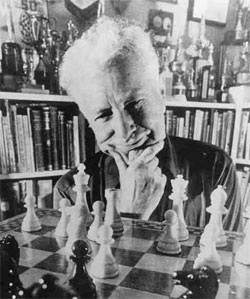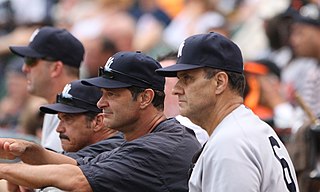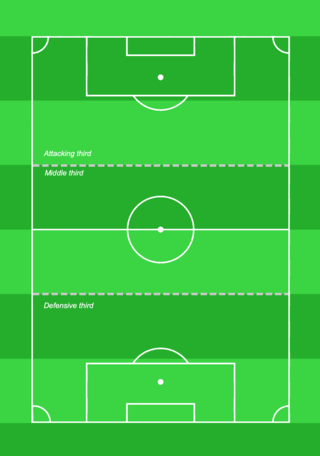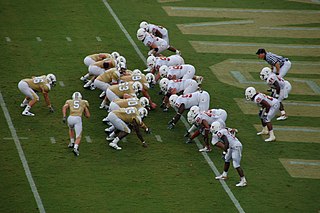
The Elo rating system is a method for calculating the relative skill levels of players in zero-sum games such as chess or esports. It is named after its creator Arpad Elo, a Hungarian-American physics professor.

In many team sports, defense or defence is the action of preventing an opponent from scoring. The term may also refer to the tactics involved in defense, or a sub-team whose primary responsibility is defense. Similarly, a defense player or defender is a player who is generally charged with preventing the other team's forwards from being able to bear down directly on their own team's goalkeeper or goaltender. Such positions exist in association football, ice hockey, water polo and many other sports.
A core competency is a concept in management theory introduced by C. K. Prahalad and Gary Hamel. It can be defined as "a harmonized combination of multiple resources and skills that distinguish a firm in the marketplace" and therefore are the foundation of companies' competitiveness.

Fantasy football is a game in which the participants serve as owners and general managers of virtual gridiron football teams. The competitors select their rosters by participating in a draft in which all relevant National Football League (NFL) players are available. Fantasy points are awarded in weekly matchups based on the actual performances of football players in real-world competition. The game typically involves the NFL, but can also involve other leagues, such as the Canadian Football League or NCAA.

Gridiron football, also known as North American football, or in North America as simply football, is a family of football team sports primarily played in the United States and Canada. American football, which uses 11 players, is the form played in the United States and the best known form of gridiron football worldwide, while Canadian football, which uses 12 players, predominates in Canada. Other derivative varieties include arena football, flag football and amateur games such as touch and street football. Football is played at professional, collegiate, high school, semi-professional, and amateur levels.

An athletic coach is a person coaching in sport, involved in the direction, instruction, and training of a sports team or athlete.

Team tactics as well as individual skills are integral for playing association football. In theory, association football is a very simple game, as illustrated by Kevin Keegan's namely assertion that his tactics for winning a match were to "score more goals than the opposition". Tactical prowess within the sport is nonetheless a craftsmanship of its own, and one of the reasons why managers are paid well on the elite level. Well-organised and ready teams are often seen beating teams with more skillful players on paper. Manuals and books generally cover not only individual skills but tactics as well.

There are various systems of Go ranks and ratings that measure the skill in the traditional board game Go. Traditionally, Go rankings have been measured using a system of dan and kyu ranks. Especially in amateur play, these ranks facilitate the handicapping system, with a difference of one rank roughly corresponding to one free move at the beginning of the game. This system is also commonly used in many East Asian martial arts, where it often corresponds with a belt color. With the ready availability of calculators and computers, rating systems have been introduced. In such systems, a rating is rigorously calculated on the basis of game results.
Strategy plays a crucial role in American football. Both teams carefully plan various aspects of their gameplay in an effort to win. This includes deciding on formations, selecting players for specific positions, and assigning roles and instructions to each player on offense and defense.
A ranking is a relationship between a set of items, often recorded in a list, such that, for any two items, the first is either "ranked higher than", "ranked lower than", or "ranked equal to" the second. In mathematics, this is known as a weak order or total preorder of objects. It is not necessarily a total order of objects because two different objects can have the same ranking. The rankings themselves are totally ordered. For example, materials are totally preordered by hardness, while degrees of hardness are totally ordered. If two items are the same in rank it is considered a tie.

A sports rating system is a system that analyzes the results of sports competitions to provide ratings for each team or player. Common systems include polls of expert voters, crowdsourcing non-expert voters, betting markets, and computer systems. Ratings, or power ratings, are numerical representations of competitive strength, often directly comparable so that the game outcome between any two teams can be predicted. Rankings, or power rankings, can be directly provided, or can be derived by sorting each team's ratings and assigning an ordinal rank to each team, so that the highest rated team earns the #1 rank. Rating systems provide an alternative to traditional sports standings which are based on win–loss–tie ratios.
Competence is the set of demonstrable characteristics and skills that enable and improve the efficiency or performance of a job. Competency is a series of knowledge, abilities, skills, experiences and behaviors, which leads to effective performance in an individual's activities. Competency is measurable and can be developed through training.

Sports table football is a competitive form of tabletop football which simulates association football. Since 1992, the sport has been governed worldwide by the Federation of International Sports Table Football (FISTF). Informal play of such games date back to Newfooty Company in 1929, with Subbuteo Sports Games introducing the style of figure used in modern sports table football in 1947. (See Tabletop football § History for details.)
Sports law in the United States overlaps substantially with labor law, contract law, competition or antitrust law, and tort law. Issues like defamation and privacy rights are also integral aspects of sports law. This area of law was established as a separate and important entity only a few decades ago, coinciding with the rise of player-agents and increased media scrutiny of sports law topics.

Wheelchair football is a variation of gridiron football played in wheelchairs.
Capability management is the approach to the management of an organization, typically a business organization or firm, based on the "theory of the firm" as a collection of capabilities that may be exercised to earn revenues in the marketplace and compete with other firms in the industry. Capability management seeks to manage the stock of capabilities within the firm to ensure its position in the industry and its ongoing profitability and survival.
Performance Index Rating (PIR) is a basketball mathematical statistical formula that is used by the Euroleague Basketball Company's first and second tier competitions, the EuroLeague and the EuroCup, as well as various European national domestic and regional leagues. It is a part of the Tendex basketball rating system. It is also variously referred to as Performance Index Ranking, Rating, Ranking, Evaluation, Valuation, and Efficiency. It is similar to, but not exactly the same as, the NBA's Efficiency (EFF) stat.

3x3 basketball is a variation of basketball played three-a-side, with one backboard and in a half-court setup. This basketball game format is currently being promoted and structured by FIBA, the sport's governing body. Its primary competition is an annual FIBA 3X3 World Tour, comprising a series of Masters and one Final tournament, and awarding six-figure prize money in US dollars. The FIBA 3x3 World Cups for men and women are the highest tournaments for national 3x3 teams. The 3x3 format has been adopted for both the 2020 Summer Olympics and 2022 Commonwealth Games.
Universal Tennis Rating (UTR) is the global tennis player rating system intended to produce an objective, consistent, and accurate index of players' skill in the game of tennis. UTR rates all players on a single 16-point scale, without regard to age, gender, nationality, or locale of a given match. All professional players in the Association of Tennis Professionals (ATP) and the Women’s Tennis Association (WTA) have UTRs, as do most college players and many junior tournament players worldwide, as well as many adult league and tournament players. The UTR database includes results from more than 8 million matches and 200+ countries. More than 800,000 players have UTRs.
Sports analytics are collections of relevant historical statistics that can provide a competitive advantage to a team or individual by helping to inform players, coaches and other staff and help facilitate decision-making both during and prior to sporting events. The term "sports analytics" was popularized in mainstream sports culture following the release of the 2011 film Moneyball. In this film, Oakland Athletics general manager Billy Beane relies heavily on the use of baseball analytics to build a competitive team on a minimal budget, building upon and extending the established practice of Sabermetrics.
Douglas et al., a scale for the mathematical ranking of amateur athletes in competitive sports, Journal of statistical analysis of amateur athletics, vol. 17, issue: 5, p. 557










